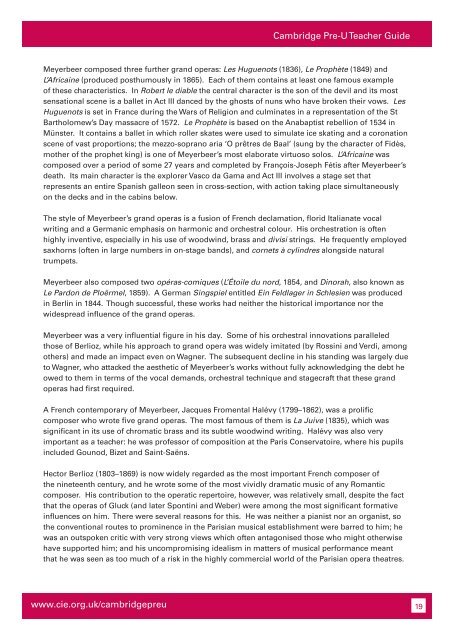Teacher's Guide Cambridge Pre-U MUSIC Available for teaching ...
Teacher's Guide Cambridge Pre-U MUSIC Available for teaching ...
Teacher's Guide Cambridge Pre-U MUSIC Available for teaching ...
Create successful ePaper yourself
Turn your PDF publications into a flip-book with our unique Google optimized e-Paper software.
<strong>Cambridge</strong> <strong>Pre</strong>-U Teacher <strong>Guide</strong><br />
Meyerbeer composed three further grand operas: Les Huguenots (1836), Le Prophète (1849) and<br />
L’Africaine (produced posthumously in 1865). Each of them contains at least one famous example<br />
of these characteristics. In Robert le diable the central character is the son of the devil and its most<br />
sensational scene is a ballet in Act III danced by the ghosts of nuns who have broken their vows. Les<br />
Huguenots is set in France during the Wars of Religion and culminates in a representation of the St<br />
Bartholomew’s Day massacre of 1572. Le Prophète is based on the Anabaptist rebellion of 1534 in<br />
Münster. It contains a ballet in which roller skates were used to simulate ice skating and a coronation<br />
scene of vast proportions; the mezzo-soprano aria ‘O prêtres de Baal’ (sung by the character of Fidès,<br />
mother of the prophet king) is one of Meyerbeer’s most elaborate virtuoso solos. L’Africaine was<br />
composed over a period of some 27 years and completed by François-Joseph Fétis after Meyerbeer’s<br />
death. Its main character is the explorer Vasco da Gama and Act III involves a stage set that<br />
represents an entire Spanish galleon seen in cross-section, with action taking place simultaneously<br />
on the decks and in the cabins below.<br />
The style of Meyerbeer’s grand operas is a fusion of French declamation, florid Italianate vocal<br />
writing and a Germanic emphasis on harmonic and orchestral colour. His orchestration is often<br />
highly inventive, especially in his use of woodwind, brass and divisi strings. He frequently employed<br />
saxhorns (often in large numbers in on-stage bands), and cornets à cylindres alongside natural<br />
trumpets.<br />
Meyerbeer also composed two opéras-comiques (L’Étoile du nord, 1854, and Dinorah, also known as<br />
Le Pardon de Ploërmel, 1859). A German Singspiel entitled Ein Feldlager in Schlesien was produced<br />
in Berlin in 1844. Though successful, these works had neither the historical importance nor the<br />
widespread influence of the grand operas.<br />
Meyerbeer was a very influential figure in his day. Some of his orchestral innovations paralleled<br />
those of Berlioz, while his approach to grand opera was widely imitated (by Rossini and Verdi, among<br />
others) and made an impact even on Wagner. The subsequent decline in his standing was largely due<br />
to Wagner, who attacked the aesthetic of Meyerbeer’s works without fully acknowledging the debt he<br />
owed to them in terms of the vocal demands, orchestral technique and stagecraft that these grand<br />
operas had first required.<br />
A French contemporary of Meyerbeer, Jacques Fromental Halévy (1799–1862), was a prolific<br />
composer who wrote five grand operas. The most famous of them is La Juive (1835), which was<br />
significant in its use of chromatic brass and its subtle woodwind writing. Halévy was also very<br />
important as a teacher: he was professor of composition at the Paris Conservatoire, where his pupils<br />
included Gounod, Bizet and Saint-Saëns.<br />
Hector Berlioz (1803–1869) is now widely regarded as the most important French composer of<br />
the nineteenth century, and he wrote some of the most vividly dramatic music of any Romantic<br />
composer. His contribution to the operatic repertoire, however, was relatively small, despite the fact<br />
that the operas of Gluck (and later Spontini and Weber) were among the most significant <strong>for</strong>mative<br />
influences on him. There were several reasons <strong>for</strong> this. He was neither a pianist nor an organist, so<br />
the conventional routes to prominence in the Parisian musical establishment were barred to him; he<br />
was an outspoken critic with very strong views which often antagonised those who might otherwise<br />
have supported him; and his uncompromising idealism in matters of musical per<strong>for</strong>mance meant<br />
that he was seen as too much of a risk in the highly commercial world of the Parisian opera theatres.<br />
www.cie.org.uk/cambridgepreu 19
















